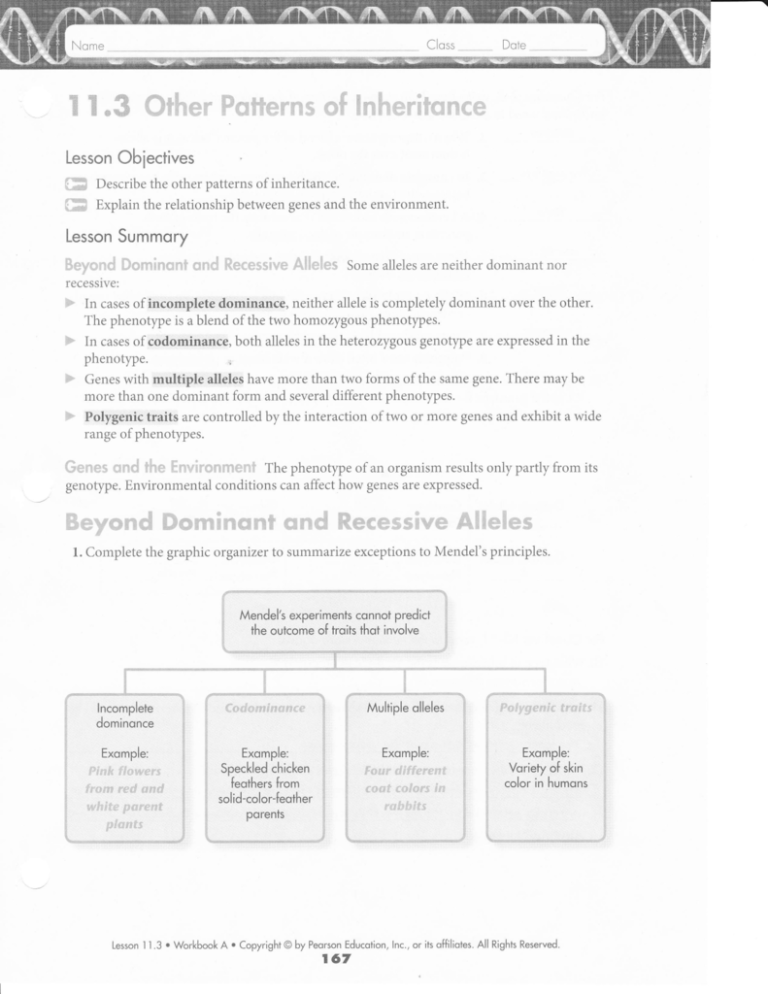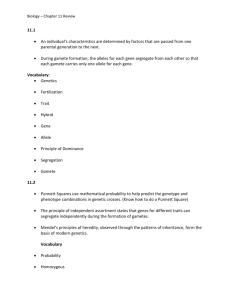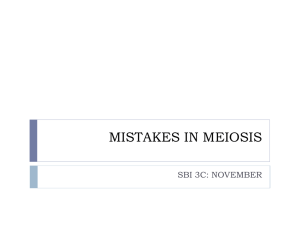
re
W
.m Other Potterns of lnheritsnce
Lesson Obiectives
[El
(t
Describe the other patterns of inheritance.
Explain the relationship between genes and the environment.
Lesson Summory
Beyond Dominonl ond Recessive Alleles
Some alleles are neither dominant nor
recessive:
ts
In cases of incomplete dominance, neither allele is completely dominant over the other.
The phenotlpe is a blend of the two homozygous phenotypes.
l>
In
I
cases of
codominance, both alleles in the heterozygous genotlpe are expressed in the
phenotlpe.
i
Genes with multiple alleles have more than two forms of the same gene. There may be
more than one dominant form and several different phenotypes.
ts Polygenic traits
are controlled by the interaction of two or more genes and exhibit a wide
range ofphenotypes.
Genes qnd the Environmenl The phenotype of an organism results only partly from its
genotype. Environmental conditions can affect how genes are expressed.
tseyond Dominont qnd Recessive Alleles
l. Complete the graphic organizer to summarize exceptions to Mendel's principles.
Mendel's experimenfs connot predict
the outcome of troits thot involve
Palygenic traits
Codaminance
Muhiple olleles
Exomple:
Exomple:
Exomple:
Exomple:
I,lnh flawers
from red and
whtte psrent
plants
Speckled chicken
feathers from
Four different
caat colors in
:Voriety oi skin
color in humcns
lncomplete
dominonce
Lesson I I
.3
so[id-color-feofier
rahhits
porents
.
Workbook A
.
Copyright @ by Peorson Educotion, lnc., or its offiliotes. All Rights Reserved.
167
For Quesfions 2-8, wrife True if lhe slalemenl is frue. lf the stolement is folse, chonge the
underlined word fo moke lhe stolement true.
2. When offspring show a blend of the parents' traits, one allele
is dominant over the other.
3.
In complete dominance, the heterozygous phenotlpe lies somewhere
between the two homozygous phenotypes.
individual that exhibits the traits of both
parents is an example of codominance.
4. A heterozygous
5. Many genes exist in several forms and are said to have
codominant alleles.
6. While muitiple
alleles may exist in a population, an individual usually
carries only two alleles for each gens.
7. Traits produced by two or more genes are codominant.
8- Polygenic traits often show a wide range of phcnalypcs.
9. A piant breeder produced a purple flower by crossing a red parent
with a blue parent. Use
RR as the genotype for the red parent and BB for the blue parent. Complete the Punnett
square to show the resulting genot)?es and phenotlpes of the offspring.
Gomete ollele:
Gomete ollele:
For Questions
10.
I
l.
12.
Gomete ollele:
Gomete ollele:
Genotype:
Genoiype:
Phenotype:
Phenotype:
Genotype:
Genotype:
Phenotype:
Phenotype:
I0-l I , refer lo lhe Punnell squore obove.
What type of inheritance is the example in Question
9?
If the offspring had been red and blue spotted flowers, what kind of inheritance would be
most likely?
Explain the difference between multiple alleles and polygenic traits.
Lesson I I
.3
.
Workbook A
.
Copyright @ by Peorson Educotion, lnc., or its offiliotes. All Rights Reserved.
t68
ffi,s*n**,* wmd 'trh* ffimqs*rmmmeqEF
3-l 6, complele eoch stolemenl by writing in fhe correcl word or words.
13. An organism's ;*.{a*ru4+{f,ir-s results from its genotype and its environment.
For Quesfrb ns
14.
I
g?r:*Fls.s produce variable traits depending on environmental conditions.
Some
white butterflies vary in their wing color because
depending on when they hatch.
15. Western
16.
iic:$f.?er*sli:€s,r* is an
their
alr;l"i;'i"*'trr"'*arij{ varies
environmental variable that affects wing color in western white
butterflies.
For eoch of the following exomples, write G if lhe troif is delermined by genolype, and E if it
is delermined by environmenl.
Turtles whose eggs hatch at higher temperatures tend to be female.
17.
18.
r,.
l
A blue-eyed girl is born to two blue-eyed parents.
Bees in a colony are assigned different jobs. As they develop, workers
19.
begin to look dramatically different.
20.
21.
A pair of twins is separated at birth. They grow up in different countries
and speak different languages.
ai:
,*.
A litter of puppies is born. They are alI gray except one, which is brown.
))
Tall pea plant seeds are planted in different locations around
produce plants of different heights.
23.
A kitten is born with six toes.
24.
A rabbit is born weak with hunger.
25.
a
yard. They
has brown eyes, and the mother has green
eyes. Two puppies have brown eyes. One has green eyes. One puppy has blue eyes. What
does this tell you about how the cellular information for eye color is passed on? Explain.
A doggave birth to four puppies. The father
Lesson I
1.3
.
Workbook
A . Copyright
@ by Peorson Educotion, lnc.,
169
or its offiliotes. All Righis Reserved
WW
.&
futecm"sas
Lesson Obiectives
{ffi
Contrast the number of chromosomes in body cells and in gametes.
1.ffi Summarizethe events of meiosis.
{ffi
Contrast meiosis and mitosis.
'{ffi
Describe how alleles from different genes can be inherited together.
Lesson Summory
fiilil'*; ffitclg*lii',er fid{ltrs}h"ign Homologous chromosomes are pairs of chromosomes that
correspond in body cells. One chromosome from each pair comes from each parent.
e
A cell that contains both sets of homologous chromosomes has a diploid number
chromosomes (meaning "two sets").
#'
Haploid cells contain only one set of chromosomes. Gametes are haploid.
of
Fh*sa:g n$ *-Xttei*sis Meiosis is the process that separates homologous pairs of chromosomes in a diploid cell, forming a haploid gamete. The phases are as follows:
&
Meiosis I, which is preceded by a replication of chromosomes. Its stages are
. Prophase I: Each replicated chromosome pairs with its corresponding homologous
chromosome forming a tetrad. During tetrad formation, alleles can be exchanged
between chromatids, a process called crossing-over.
. Metaphase I: Paired homologous chromosomes line up across the center of the cell.
. Anaphase I: Spindle fibers pull each homologous pair toward opposite ends of the cell.
. Telophase I: A nuclear membrane forms around each cluster of chromosomes.
Cytokinesis then occurs, resulting in two new cells. The resulting daughter cells contain
chromosome sets that are different from each other and the parent cell.
b
Meiosis II: Chromosomes do not replicate.
. Prophase II: Chromosomes, each consisting of two chromatids, become visible.
. Metaphase II, Anaphase II, Telophase II, and Cytokinesis: These phases are similar
to meiosis I. Four haploid cells form. They are the gametes. During fertilization, two
gametes unite formi ng a zygote.
{i*mp*n"!ng ffiei*si: e:nd i4i**sis
P Mitosis is one cell division that results in two genetically identical diploid cells.
*' Meiosis is two cell divisions that result in four genetically different haploid cells.
,-?s;rc' Lrnkars;r cmei Geffie
i';,*F
tr
Alleles tend to be inherited together if they are located on the same chromosome.
s*
Chromosomes, not genes, segregate independently.
b
The farther apart genes are on a chromosome, the more likely is cross over.
&r"
Information on linkage and the frequency of crossing-over lets geneticists construct
maps of the locations of genes on chromosomes.
Lesson I I
.4
.
Workbook
A . Copyright
@ by Peorson Educotion, lnc.,
170
or its offiliotes. All Rights Reserved.
Number
O Chromosome
if
l-8,
write True fhe stotement is lrue. lf lhe stotement is folse, chonge lhe
underlined word lo make the slotement frue.
For Questions
True
l.
The offspring of two parents obtains a single copy of every gene from
each parent.
True
1
A gamete must contain one complete set of genes.
chromosomes
3. Genes are located at specific positions on spindles.
homologous
4. A pair of corresponding chromosomes is homozygous.
porent
5. One member of each homologous chromosome pair comes
each sene.
diploid
6. A cell that contains both sets of homologous chromosomes is
from
haoloid.
True
7. The gametes of sexually reproducing organisms are haploid.
t2
8.
If an organism's haploid number is 6, its diploid number is 3.
Phoses of Meiosis
On fhe lines provided, identify fhe
occurs.
ProPhase
I
9.
sfoge
of meiosis I or
meiosis
ll in which lhe event described
Each replicated chromosome pairs with its corresponding
homologous chromosome.
I
PraPhose
10. Crossing-over occurs between tetrads.
I
MetaPhase
ll.
Paired homologous chromosomes line up across the center of the
cell.
AnaPhase
I
TeloPhose
I
ProPhase
Il
TeloPhase
Il
Lesson
1
12. Spindle fibers pull each homologous chromosome pair toward an
opposite end of the cell.
13. A nuclear membrane forms around each cluster of chromosomes and
cytokinesis follows, forming two new cells.
14. Chromosomes consist of two chromatids, but they do not pair to
form tetrads.
15. A nuclear membrane forms around each cluster of chromosomes and
cytokinesis follows, forming four new cells.
l 4 . Workbook
A . Copyright
@ by Peorson Educotion, lnc.,
t7t
or its offiliotes. All Rights Reserved.
f
6.
, Draw two homologous pairs of chromosomes (in different colors if
you have them) in these diagrams to illustrate what happens during these three phases of
meiosis.
,/
._a,li.r\
/-
------rtr\
/ 4., ///t'.e.$
-Qj\
/ /:'..: ;''././//./t,t\\
,'///ll\\
/,/ll
h,
\\Il///
ti "\."/
/
rr
,,11,
I
I
\\ll//./t,/,
\\\ll l/./ ./ .\, \'./
\,.\')'/,/./A
//-.""/ //
\\!g
\-.9 :./ --/
,/
\/tns.iY,---l
./
\\--.Prophase
I
Metaphase
I
/ /-\
/' tffi.r-'\
fu$:'rtl.
/ ,/
,/ /--\\
.///ti,
t
/,1//|il\
rlWfi;/ "/ t/
)":,/ ,//
{ie
\\\\"/zz
rJ.o;'1.4
Anaphase ll
lT.IdentiSr which phase of meiosis is shown in the diagrams below.
lo
Use lhis diogrom
18.
onswer Quesfrons t 8-20.
What does the diagram shorv?
:,..::
19.
.'
:
During what phase of meiosis does this process
occur?
20. What is the result of this process?
Lesson I I
.4
.
Workbook
A
.
Copyright @ by Peorson Educotion, lnc., or its offiliotes. All Rights Reserved.
t72
O
snd foti?*sls
*e:smpmrfimg &€**ss$s
21. Complete the table to compare meiosis and mitosis.
i"*ssxs€nj
Form of reproduction
a
;
i Number of doughter cells
I Chong" in chromosome number . *:'t tksnge; stays
f-;;: ,;: f.srff tr: it*p!*itl
dip!*i,i
I
i-
i Nrrb"r
of cell divisions
i
iI
oit_
:'
N*ne
; Difference in olleles between
: porent cell ond doughter cells
€srJa
sf
fJrs {ns-rr da*rSht,,:
ceils is geneiia:*:e'Iv
differtnt
from t-*e pxt::+t,
!
..
For Queslions 22-27, complele eoch sfalement by writing lhe correcl word or words.
22.
A diploid cell that enters
mitosis with 16 chromosomes will divide to produce
daughter cells. Each of these daughter cells will have
I6
chromosomes.
23.
If the diploid number of chromosomes for an organism is 16, each daughter cell after
g,{.t
mitosis will contain
24.
chromosomes.
A diploid cell that enters meiosis with
u
will
fs{'ri:*{:ltef number of chromosomes.
26,If an organism's haploid number is 5, its diploid number is
27.While
a
pass through
daughter cells, each with
cell divisions, producing
chromosomes.
25. Gametes have
16 chromosomes
tv
haploid number of chromosomes may be even or odd, a diploid number is always
€9'{n
B
Lesson I
l 4 . Workbook
A
.
Copyright @ by Peorson Educotion, lnc., or its offiliotes. All Rights Reserved.
173
28. What did Thomas
Hunt Morgan discover that seemed to violate Mendel's principles?
29.How did Morgan explain his finding?
30. How did
Alfred Sturtevant use gene linkage to create gene maps?
Use this diogrom fo onswer Quesfions
3t-34.
Exact location on chromosome
0.0
1.3
13.0
31.0
Chromosome 2
Aristaless (no bristles on antenna)
Star eye
Dumpy wing
0
10
20
Dachs {short legs)
30
48.5 Black body
51.0
Reduced bristles
54.5
Purple eye
40
50
55.0 Light eye
I
r,l
67.0
75.5
60
7o
Vestigial (small) wing
Curved wing
80
90
99.2
104.5
Arc {bent wings)
Brown eye
Speck wing
100
110
31. What does the diagram show?
32. How was the
33.
information in this diagram gathered?
Which pairs of characteristics are more likely to cross over: curved wing and dumpy wing;
or curved wing and vestigial (small) wing? Why?
34. Which pair of genes shown is least likely to cross over?
i
i
How do you know?
'l:'_:j
Lesson I I
.4
.
Workbook A
.
..:)- t:
,i
.:r:.,
-.::-
r.,:r,i::i:
j,".:
: .e:
Copyright @ by Peorson Educotion, lnc., or iis offiliotes. All Rights Reserved.
174
...i
I
Use this diogrom to onswer Quesfrbns 35-38.
A,4A . B
r.
A q B'
a
C o
D
C5
20
D
-A8B179j2D
( B
C
J
,
,
h
1.
tL
A
o
u
,
D
t
35.In which gene map is the probability of crossing-over between A and D greatest?
36.In which gene map is the probability of crossing-over between A and D the least?
D
3T.Inwhich map
are genes C and D most closely linked?
38.In map D, which genes are least likely to cross over?
CandB
39. Some housecats have orange fur with darker orange stripes. The traits of these tabby cats
are usually seen in male cats. Tortoiseshell cats have patches of many different colors.
"Torties," as they are called, are almost always female. What does this tell you about the
way cellular information about color and sex are passed on in cats?
It tells me that the genes for color and sex are linked. The genes for these two traits
must be locoted on the same chromosome,
Lesson
'l
,l.4
.
Workbook A
.
Copyright @ by Peorson Educotion. lnc., or its offiliotes. All Rights Reserved.
175









